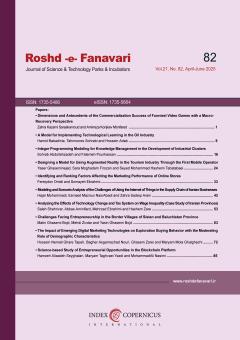مدل سازی برنامه ریزی عدد صحیح برای مدیریت دانش در توسعه خوشههای صنعتی
الموضوعات : Knowledge Management
سهراب عبدالهزاده
1
![]() ,
فاطمه پور حسن
2
,
فاطمه پور حسن
2
![]()
1 - دانشکده فناوری های صنعتی، دانشگاه صنعتی ارومیه، ایران
2 - گروه مهندسی صنایع دانشگاه صنعتی ارومیه
الکلمات المفتاحية: مدیریت دانش, خوشههای صنعتی, دانش گروهی, عملکرد نوآورانه, بهرهوری,
ملخص المقالة :
در پژوهش جاری، یک مدل ریاضی برنامه ریزی عدد صحیح برای مدیریت دانش در توسعه خوشههای صنعتی ارائه شده است. هر خوشه صنعتی متشکل از تعدادی عضو بوده و سبدهای تخصصی مشتمل بر تعدادی برنامه جهت ارتقای دانش وجود دارد. سبدهای تخصصی و برنامه های ارتقای دانش، هزینه اجرای برنامه ها به صورت مشترک و مجزا و میزان تاثیر آن ها بر انواع دانش و در هر سطح مهارتی، معلوم است. مدل پیشنهادی با توجه به محدودیت بودجه، از هر سبد تخصصی، برنامه هایی را که بیشترین تاثیر بر دانش دارند، انتخاب می کند. به منظور اعتبار سنجی، مدل ریاضی پیشنهادی برای ده شرکت دانش بنیان مستقر در پارک فناوری با پنج سبد تخصصی و 13 برنامه به کار گرفته شد. برنامهها، شش نوع دانش کارکنان اعضای خوشه را در در سه سطح مهارتی کم، متوسط و زیاد، ارتقا میبخشد. مدل ریاضی برنامه ریزی عدد صحیح با نرم افزار گمز کد نویسی و حل شده و برنامه های کارگاه طراحی محصول، دوره آموزشی مدیریت بازرگانی، شرکت در نمایشگاه داخلی، تور صنعتی بازدید از صنایع خارجی2 و تور بازدید از نمایشگاه خارجی، انتخاب شدند. تاثیر برنامه ها بر دانش خوشه و نسبت ارتقای دانش به هزینه اجرا محاسبه شد. براساس نتایج بدست آمده، همچنین، مدل ریاضی پیشنهادی در ایجاد همسویی و ارتقای دانش در اعضا با رویکرد خوشهای، از کارایی مناسبی برخوردار بوده و در صورت اجرای برنامهها به صورت مشترک، هزینه ارتقای دانش به میزان قابل توجهی کاهش مییابد.
جعفرنژاد، احمد؛ مومنی، منصور؛ مروتی شریف آبادی، علی و کریمی زارچی، محمد (1399). طراحی مدل توسعه پایدار خوشه های صنعتی. فصلنامه علوم و تکنولوژی محیط زیست, 22(3), 193–203.
[2] دانش شکیب، معصومه (1397). ارائه مدل پویای توسعه سرمایهگذاری و بهبود مزیت رقابتی خوشههای صنعتی ایران. نشریه علمی پژوهشی مدیریت کسب و کارهای بین المللی, 1(2), 111–134.
[3] A. Amin and N. Thrift, “Institutional issues for the European regions: from markets and plans to socioeconomics and powers of association,” in The New Industrial Geography, Routledge, 2002, pp. 292–314.
[4] N. Wickramasinghe, A. Fadlalla, and E. Geisler, “Knowledge management and data mining: Strategic imperatives for healthcare,” 2003.
[5] D. J. Teece, “Strategies for Managing Knowledge Assets: The role of firm structure and industrial context (in: Managing Industrial Knowledge,” Creation, transfer and utilization. London. Sage Publications, pp. 125–144, 2001.
[6] C.-C. Huang, “Knowledge sharing and group cohesiveness on performance: An empirical study of technology R&D teams in Taiwan,” Technovation, vol. 29, no. 11, pp. 786–797, 2009.
[7] A. T. Arikan, “Interfirm knowledge exchanges and the knowledge creation capability of clusters,” Acad. Manag. Rev., vol. 34, no. 4, pp. 658–676, 2009.
[8] A. De Bem Machado, S. Secinaro, D. Calandra, and F. Lanzalonga, “Knowledge management and digital transformation for Industry 4.0: A structured literature review,” Knowl. Manag. Res. Pract., vol. 20, no. 2, pp. 320–338, 2022.
[9] S. Breschi and F. Malerba, “The geography of innovation and economic clustering: some introductory notes,” Ind. Corp. Chang., vol. 10, no. 4, pp. 817–833, 2001.
[10] C. Casanueva, I. Castro, and J. L. Galán, “Informational networks and innovation in mature industrial clusters,” J. Bus. Res., vol. 66, no. 5, pp. 603–613, 2013.
[11] J. Xiong, Z. Duan, and Y. Wang, “Modeling and simulation of the inter-organizational knowledge transfer impact factors in industrial clusters,” in The 19th International Conference on Industrial Engineering and Engineering Management: Management System Innovation, 2013, pp. 161–171.
[12] A. Moarrefi, V. Ashtiyani, and M. Ilanloo, “Industrial Clusters, Theory and Applications in Urban and Regional Planning, Qom.” Aien Mahmoud Press, 2013.
[13] V. E. Hoffmann, G. S. C. Lopes, and J. J. Medeiros, “Knowledge transfer among the small businesses of a Brazilian cluster,” J. Bus. Res., vol. 67, no. 5, pp. 856–864, 2014.
[14] L. Sarach, “Analysis of cooperative relationship in industrial cluster,” Procedia-Social Behav. Sci., vol. 191, pp. 250–254, 2015.
[15] L. Mayangsari, S. Novani, and P. Hermawan, “Batik solo industrial cluster analysis as entrepreneurial system: a viable co-creation model perspective,” Procedia-Social Behav. Sci., vol. 169, pp. 281–288, 2015.
[16] N. Wardhani, N. Noermijati, and S. Sunaryo, “Knowledge-Worker Productivity in Defense Industry: The Role of Knowledge Management through Employees’ Adaptability and Job Satisfaction,” Media Ekon. dan Manaj., vol. 37, no. 1, pp. 140–160, 2022.
[17] T. Sonar, V. Balasubramanian, S. Malarvizhi, T. Venkateswaran, and D. Sivakumar, “Multi-response mathematical modelling, optimization and prediction of weld bead geometry in gas tungsten constricted arc welding (GTCAW) of Inconel 718 alloy sheets for aero-engine components,” Multiscale Multidiscip. Model. Exp. Des., vol. 3, pp. 201–226, 2020.


